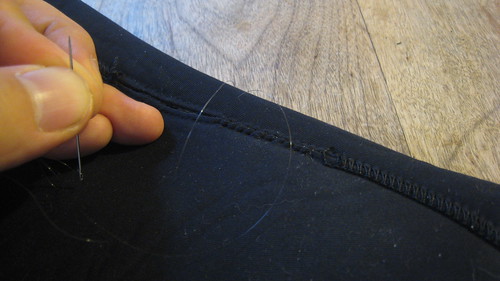Noticed last week when getting out of the water that one of the sewn seams on my Xcel infiniti hooded fullsuit has the thread stripped off about 2 inches on the forearm. The tape underneath had held and I hadn’t felt REALLY cold water hit my arm. The neoprene had spread apart just slightly.
I know you can send back suits to Xcel (they supposedly have a great warranty program) — but figured by the time I got it back the early season would be done and I’d be missing out not having it (the water is still hovering between 38 and 40°F).
What to do? Repair it myself. Figured I’d share with everyone how to do it. The trick is to repair it so it remains flexible and strong — and make TRIPLY sure it’s still water tight.
(this covers one specific type of re-stitch)
What you need:
* A clean suit (don’t sewn in some seaweed and later wonder what stinks !!)
* Some 100% Nylon thread (black or clear/invisible) — thinner the better
* Small sharp needle, scissors, and thread puller
(I’m using nylon clear thread as it has lots of “stretch” to it and is available in clear — I’m sure you could use a very thin test fishing line if you’re in a pinch)
Start off by trying off the ends of the thread well on each end of the split — so they don’t continue to spread.
Next thread your needle doubling up the nylon thread so that you have about at least a forearms length of thread trailing/available to stitch through.
Begin sewing at one end of the spilt. Make a good start knot and then work your way slowly back up the seam. Try and follow the previous holes if possible (the fewer holes in thew suit the better) where the old thread had been. Keep the thread tight throughout with a clean stitch each time — don’t leave loops, knots, mistakes hanging as these will get caught on stuff and rip your work out quickly.
Make sure you don’t go through the seam welding TAPE underneath. Keep your stitching close to the original spacing and depth. Repeat — don’t allow your needle to go through the tape.
Once you reach the end go past the old thread slightly then start to work your way back — trying to get any gaps or openings you might have missed.
Tie your nylon thread off well and close cut with scissors. Test it out by stretching it slightly and make sure it holds.
All done! (Photos here)
—
(this doesn’t cover what to do if your inner seam tape has also ripped right through — in that case I would send it back to Excel as that is a key component between a fun session and hypothermia)
Other options include buying seam welding “goo” for wetsuits — these work well if the cut/spilt is not on a seam but in the middle of a piece of neoprene. In my experience this stuff works but looks ugly though — like you have boogers on your suit.
Lots more info on more serious repairs can be found here – http://www.ehow.com/how_117816_repair-ripped-wetsuit.html. You can also search for someone in your area that does this as a service — Google lists many.

5 responses to “Repairing your wetsuit”
Personally, I use dental floss, and a big curved needle. The dental floss is less likely to tear the neoprene and the curved needle is easy to work with. I always dab both sides of the tear with aquaseal before stitching. If the tear is in a critical chafing area, I’ll cut some t-shirt material, smear one side with aquaseal, place it on the inside of the stitch and press it hard into the neoprene. This covers up the inevitable bumps your stitching and aquaseal create.
One caveat to this method is you don’t get pretty seams like yours.
You can get water tight repair like this even when sewing a huge rip together.
Great tips Rob — especially using the aquaseal + tshirt (maybe even old rash guard material would be sweet). I’ve luckily never had a big enough tear to need that.
This is great. I have no big splits, but both my 5/4 and my 4/3 have spots where the stitching is coming unravelled. This should be a perfect way to catch it before it gets bad.
How come you didn’t try to replicate the factory stitch by hand? Is it too difficult? Or just not worth the hassle? I was thinking that the factory stitch might have more flexibility in it, or something…?
Daniel
Hi Dan,
The factory stitch seemed to use a different kind of thread and in a pattern I couldn’t replicate by hand. This stitch has held.
Steve